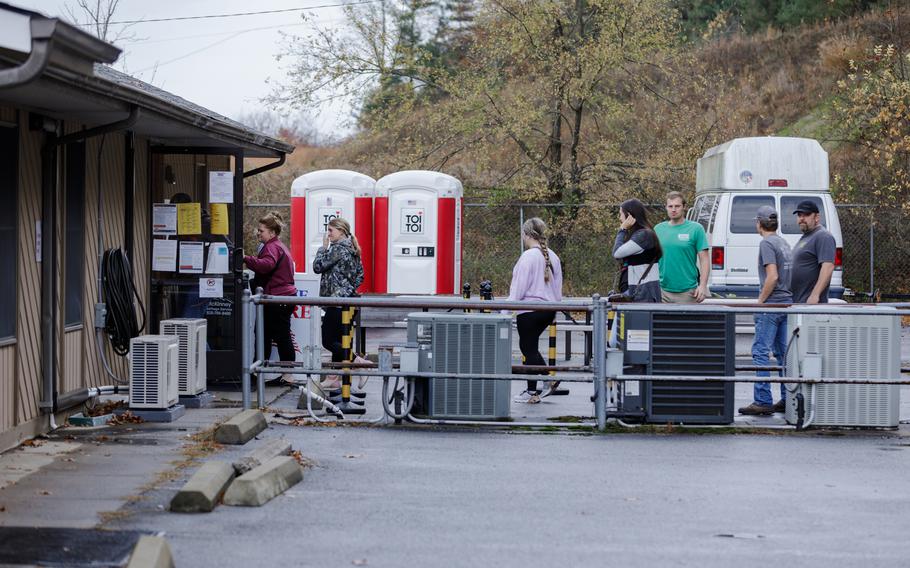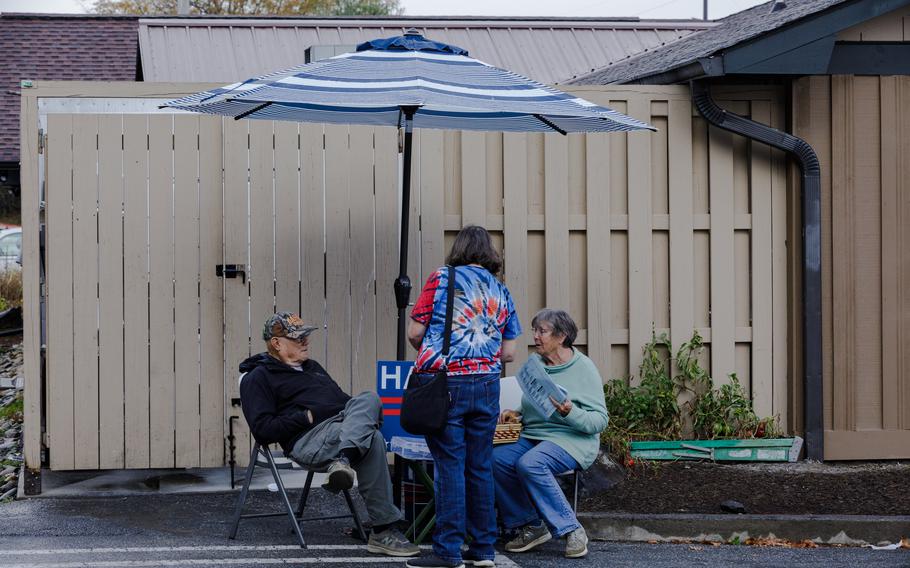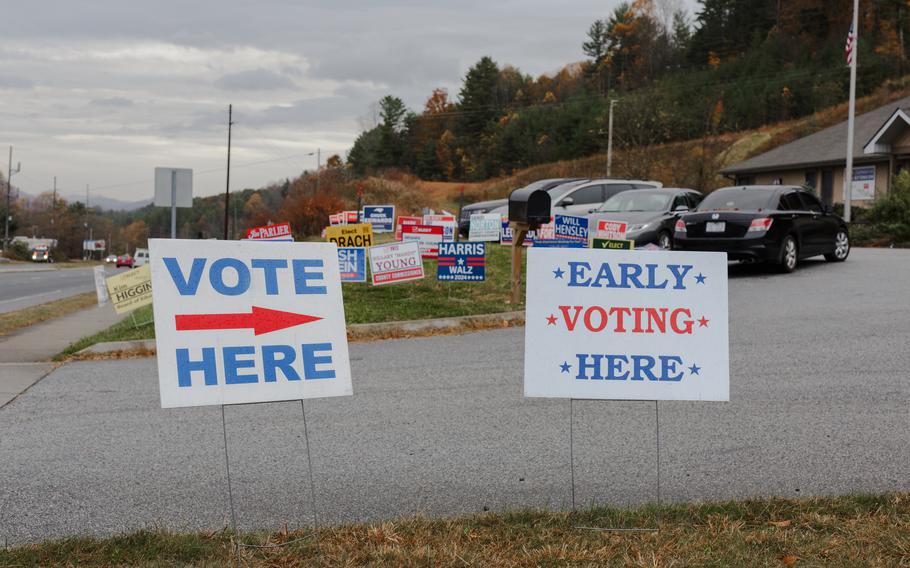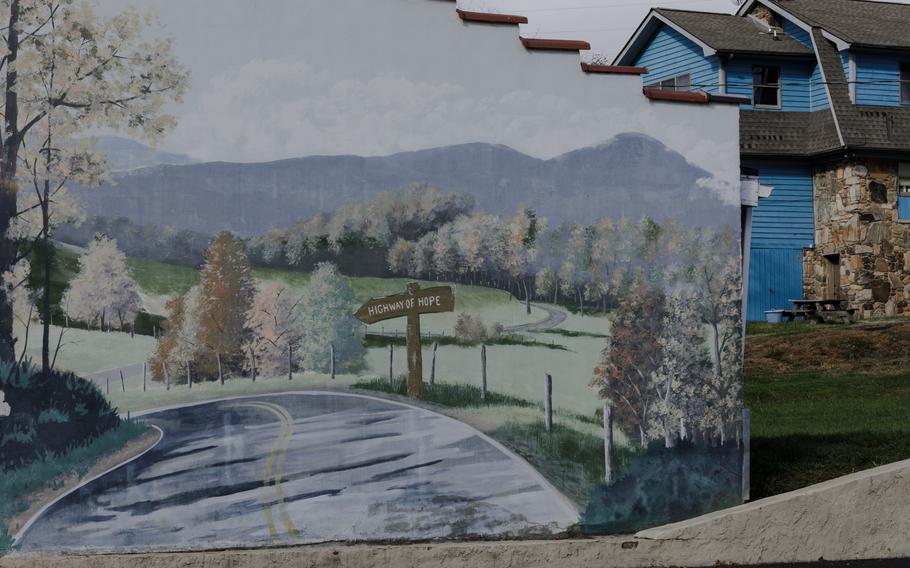
People stand in line Friday for early voting at the Yancey County Board of Elections office in Burnsville, N.C. Many residents there and elsewhere in the western part of the state are still trying to recover from Hurricane Helene. (Juan Diego Reyes for The Washington Post)
ASHEVILLE, N.C. — After weeks of thinking she knew whom she would vote for in the presidential race, Sara Randolph isn’t sure anymore.
The election left her mind entirely in late September, when Hurricane Helene wreaked havoc in Asheville and surrounding communities where Randolph, her family and longtime friends live. In the days after, she spent hours outside her home, surrounded by fallen trees, holding her phone in the air for glimmers of cell service to check if the others were safe.
“Nobody here thought about politics the first couple of weeks,” said Randolph, 41, who grew up in nearby Burnsville.
Weeks passed before North Carolina’s early voting began, and she wondered: What were the two candidates — Vice President Kamala Harris and former President Donald Trump — truly doing for the western part of the state, where the hurricane had hit the hardest? Had either helped her family, her neighbors? Or were they just offering sympathies?
For so many in the region, with nearly 100 people dead and others still missing, the election that once loomed large now felt far-flung. In the month-plus since Helene’s stunning destruction, while much of the country debated abortion, immigration and the economy, residents here worried about simpler issues: food, water, shelter.
At the same time, the battleground state was slammed by a different kind of cyclone as misinformation on social media spiraled about the federal response — with Trump amplifying false claims during a visit to Swannanoa to survey storm damage.
County officials were still able to open most polls on time when early voting began Oct. 17. And voters, despite all the challenges, turned out in record numbers. Through Saturday, when in-person early voting ended, more than 4.2 million North Carolinians had cast their ballots, according to the State Board of Elections. The 25 counties upended by Helene had a turnout of 58.9%, higher than the statewide total.

Steven and Beverly Hill talk with a North Carolina voter casting a ballot early at the Yancey County Board of Elections office in Burnsville. (Juan Diego Reyes for The Washington Post)
Randolph, an unaffiliated voter, plans to cast her ballot on Election Day. She is weighing which presidential candidate will be most present while local communities continue picking up the pieces.
“Looking at who is showing up for us versus who is not showing up for us, it’s made a big difference, a shift, in how I think,” she said Friday.
Following the hurricane, the elections board expanded voting options in those 25 counties, allowing ballots to be mailed to temporary housing locations and returned to any county’s elections office. The provisions had already been implemented when Trump’s team demanded them last month, a reversal of his stance on mail and early voting as the campaign worried about losing out on Republican voters.
Trump won North Carolina in 2020 by fewer than 80,000 votes — his narrowest margin of victory in any state. Against the ruby-red counties in the western part of the state, Buncombe County, which includes Asheville, is the brightest sapphire jewel.
Yet like Randolph, many people here have shifted their focus. They’ve been thinking about one another far more than they have been thinking about Trump or Harris.
Where intense political clashes once reigned, sowing division, the reminders of the storm’s toll have brought them together.
Down the road from where campaign signs are nailed up in Yancey County, posters showing where to find relief supplies are staked in the grass. Some residents sport red Make America Great Again caps, others the camo version that declares for Harris-Walz, but the T-shirts emblazoned with “WNC Strong” over an outline of the state are worn by supporters of both tickets.
On a gloomy day outside the elections board office, the county’s only polling place for early voting, Democrat Beverly Hill sat on a folding chair beside a basket of voting pins that read, “Prosecutor or Felon? You make the call” and “Dance the Walz.”
The site used to be rowdy in voting season, recounted Hill, a Harris-Walz cap on her head. Shouting matches and car scratches were at one point commonplace in the parking lot outside, fueled mainly by volunteers and candidates from the local GOP, Hill said. Voting there used to be “like running the gauntlet.”
This year, though, an orange line spray-painted across the lot marked a wide swath of asphalt only voters could traverse. And it was usually just Hill, her husband and a Republican electioneer who stationed themselves outside the office during each early voting day.
“She and I are working at being friendly,” said Hill, 76. “We talk about dogs.”

Yancey County, northeast of Asheville, was one of the counties most affected by Helene; some areas still are largely impassable. There is but one place for early voting. (Juan Diego Reyes for The Washington Post)
Yancey, northeast of Asheville, was one of the counties most affected by Helene; some areas still are largely impassable. When more polling places open on Tuesday, churches and fire departments among them, voters will cast their ballots at locations that continue to serve as makeshift supply centers for the recovery.
Southeast of Asheville in Polk County, Michael Marsteller went to bed the night before the storm not knowing who else lived on Big Hungry Road. As he tells it, people tend to move to the area, which is surrounded by game lands, to be left alone.
But when he woke up the next day, he knew that he needed his neighbors and that they would need him. After the wind and rain passed, they worked in teams — two chainsawing downed trees, one clearing roads, others bringing around meals so the work could keep going. One group even manned a makeshift rope zip line to pass supplies via an old shopping cart over the Big Hungry River. Floodwaters had washed away the bridge everyone relied on.
In early October, at one of the ad hoc meetings now happening nightly beside the small community’s row of mailboxes, someone asked about voting. With the bridge gone, the residents along Big Hungry Road had no way of reaching their polling place. But with power and cell service back, they’d started seeing news again and wanted to “take part in the election,” said Marsteller, 54, a retired sheriff of nearby Henderson County.
He called Polk County elections director Cliff Marrto explain the situation. Where the bridge had once been, there was now a temporary foot bridge of wooden slats, then three-story scaffolding that residents were using to climb up the bank and reach their homes.
Days later, Marr used the scaffolding to deliver 100 absentee ballots. Marsteller passed them out at the next community meeting, relaying the instructions for completing them and sealing the envelopes.
On Friday, he returned with about a dozen ballots, again meeting Marr at the scaffolding.
“If this would have happened two or three days before the election, I don’t think you’d have had anybody voting here because it’s just not what’s important at that time,” Marsteller said. “You’ve got survival.”
As for Randolph in south Asheville, even if it takes until the moment she is standing at a Buncombe County ballot machine to decide on her candidate, she will vote Tuesday. She hasn’t missed a presidential election since 2004, and she won’t let this year’s be the first.
But she has a message for whoever wins the White House: “Don’t forget about us.”

In the wake of Hurricane Helene’s devastation, a mural in downtown Burnsville points to a future of hope. (Juan Diego Reyes for The Washington Post)